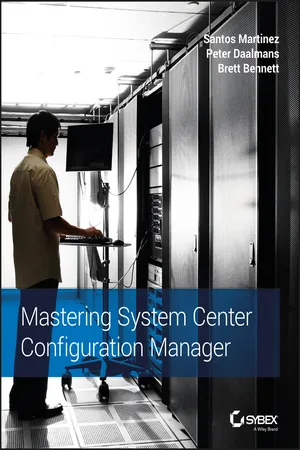
Mastering System Center Configuration Manager
- English
- ePUB (mobile friendly)
- Available on iOS & Android
Mastering System Center Configuration Manager
About This Book
Get up to date quickly with clear, expert coverage of SCCM 2016
Mastering System Center Configuration Manager provides comprehensive coverage of Microsoft's powerful network software deployment tool, with a practical hands-on approach. Written by Santos Martinez, Peter Daalmans, and Brett Bennett, this guide walks you through SCCM 2016 with in-depth explanations anchored in real-world applications to get you up to speed quickly. Whether you're planning a new installation or migrating from a previous version of Configuration Manager, this book provides clear instruction and expert insight to get the job done right. Fully aligned with the latest release, the discussion covers the newest tools and features with examples that illustrate utility in a variety of contexts.
System Center Configuration Manager (formerly SMS) is one of Microsoft's flagship products; the 2016 release has been updated with better Windows 10 and Windows Server 2016 compatibility, improved tools for managing non-Microsoft mobile devices in the cloud, and more. This book provides start-to-finish coverage and expert guidance on everything you need to get your system up to date.
- Deploy software and operating systems
- Automate processes and customize configurations
- Monitor performance and troubleshoot issues
- Manage security in the cloud and on Virtual Machines
SCCM 2016 improves your ability to handle the bring-your-own-device influx in managing mobile, streamlining the latest hiccup right into the everyday workflow. Mastering System Center Configuration Manager provides the practical coverage you need to get up and running seamlessly.
Frequently asked questions
Information
Chapter 1
Overview of System Center Configuration Manager and Microsoft Intune
A Brief History of Configuration Manager
| RELEASE NAME | RELEASE VERSION | RELEASE DATE |
| System Management Server | 1.0 | 1994 |
| System Management Server | 1.1 | 1995 |
| System Management Server | 1.2 | 1996 |
| System Management Server | 2.0 | 1999 |
| System Management Server 2003 | 2003 | 2003 |
| System Center Configuration Manager 2007 | 2007 | 2007 |
| System Center Configuration Manager 2012 | 2012 | March 2012 |
| System Center 2012 R2 Configuration Manager | 2012 R2 | 2013 |
| System Center Configuration Manager (Current Branch) | 1511 | December 2015 |
| System Center Configuration Manager (Current Branch) | 1602 | March 2016 |
| System Center Configuration Manager (Current Branch) | 1606 | July 2016 |
| System Center Configuration Manager (LTSB) Long-Term Servicing Branch | 1606 | October 2016 |
NOTE For now don’t worry about the version numbers such as 1511, 1602, 1606, and so on. We’ll discuss this topic in the “Overview of the New Servicing Model for Configuration Manager” section later in this chapter.
Configuration Manager Features

Application Management
Collections
Table of contents
- Cover
- Title Page
- Copyright
- Dedication
- Acknowledgments:
- About the Authors:
- About the Contributing Authors:
- Introduction:
- Chapter 1: Overview of System Center Configuration Manager and Microsoft Intune:
- Chapter 2: Planning a Configuration Manager Infrastructure:
- Chapter 3: Migrating to Configuration Manager:
- Chapter 4: Installation and Site Role Configuration:
- Chapter 5: Client Installation:
- Chapter 6: Client Health:
- Chapter 7: Application Deployment:
- Chapter 8: Software Updates:
- Chapter 9: Operating System Deployment:
- Chapter 10: Inventory and Software Metering:
- Chapter 11: Asset Intelligence:
- Chapter 12: Reporting:
- Chapter 13: Compliance Settings:
- Chapter 14: Endpoint Protection:
- Chapter 15: Role-Based Administration:
- Chapter 16: Disaster Recovery:
- Chapter 17: Troubleshooting:
- Chapter 18: Enterprise Mobility and Configuration Manager:
- Appendix:
- End User License Agreement